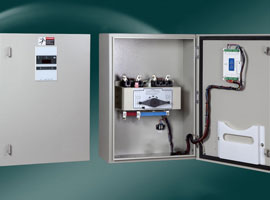Transfer Switches

Automatic transfer switches continually monitor the incoming utility power to your home or business. Any variations such as voltage drops, voltage spikes, or surges will cause the internal circuitry of the transfer switch to start the generator and then transfer your power source to the generator (instead of utility power) when additional switch circuitry determines the generator has the proper voltage and frequency. When utility power returns or no anomalies have occurred for a set of time, the transfer switch will then transfer back to utility power and instruct the generator to turn off.
Speaking of loads, let's cover a little about Transfer Switches. A transfer switch has a couple of very important functions. Transfer switches must be used to connect emergency power sources (generator) to a home. The transfer switch must keep the generators power from going out onto the utility lines at all cost. More than one lineman has been injured while working on what should have been a dead wire but was hot because of a residential generator that he didn't know was there. By the way, if you do hookup a generator to your home or business you must notify the electric company that you have a generator. Transfer switches are simple in design but carry a great burden when an emergency hits. The switch must bring both the utility and generators power into the same circuit box but only allow one or the other to be connected to the load (refrigerator). Transfer switches must interrupt the incoming power, utility or generator, before connecting it to the load.